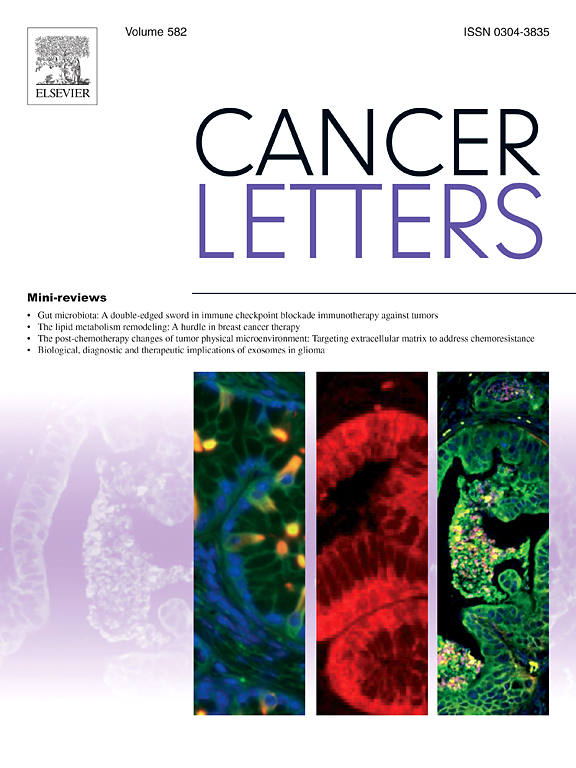m6A高甲基化诱导的PIR过表达调节H3K4me3并促进葡萄膜黑色素瘤的发生
IF 9.1
1区 医学
Q1 ONCOLOGY
引用次数: 0
摘要
葡萄膜黑色素瘤(Uveal melanoma, UM)是成人最常见的原发性眼部恶性肿瘤,其特点是死亡率高、转移性强、治疗选择有限,因此需要寻找新的治疗靶点。本研究中,我们通过综合多组学分析确定了皮林(PIR)是UM的一个关键致癌因子,揭示了PIR显著上调并与不良预后相关。功能分析表明,抑制PIR可显著抑制UM的进展,强调其在肿瘤发生行为中的关键作用。从机制上讲,PIR表达是由METTL3和IGF2BP3介导的n6 -甲基腺苷(m6A)异常修饰驱动的。同时,高表达的PIR通过与WDR5相互作用,作为转录共调控因子,调控ANAPC10启动子区域的H3K4me3修饰,进而促进ANAPC10的表达。总的来说,我们的研究揭示了METTL3/IGF2BP3 (m6A)-PIR-WDR5 (H3K4me3)-ANAPC10轴,连接RNA甲基化和组蛋白甲基化在UM发病机制中的作用。通过揭示这些复杂的表观遗传相互作用,我们为UM生物学提供了新的见解,并确定了肿瘤治疗的潜在治疗靶点,为未来的药物开发和临床应用提供了理论支持。本文章由计算机程序翻译,如有差异,请以英文原文为准。
The m6A hypermethylation-induced PIR overexpression regulates H3K4me3 and promotes tumorigenesis of uveal melanoma
Uveal melanoma (UM) is the most common primary ocular malignancy in adults, characterized by high mortality, strong metastatic potential, and limited treatment options, necessitating the identification of novel therapeutic targets. Here, we identified Pirin (PIR) as a key oncogenic factor in UM through comprehensive multi-omics analyses, revealing that PIR is significantly upregulated and correlates with poor prognosis. Functional assays indicated that inhibiting PIR markedly suppressed UM progression, highlighting its critical role in tumorigenesis behavior. Mechanistically, PIR expression is driven by aberrant N6-methyladenosine (m6A) modifications mediated by METTL3 and IGF2BP3. Meanwhile, the high expressed PIR acts as a transcriptional co-regulator by interacting with WDR5, resulting in the regulation of H3K4me3 modifications at the ANAPC10 promoter region and subsequent promotion of ANAPC10 expression. Overall, our study uncovered the METTL3/IGF2BP3 (m6A)-PIR-WDR5 (H3K4me3)-ANAPC10 axis, bridging RNA methylation and histone methylation in UM pathogenesis. By unmasking these intricate epigenetic interactions, we provided novel insights into UM biology and identified potential therapeutic targets for tumor treatment, offering the theoretical support for future drug development and clinical applications.
求助全文
通过发布文献求助,成功后即可免费获取论文全文。
去求助
来源期刊

Cancer letters
医学-肿瘤学
CiteScore
17.70
自引率
2.10%
发文量
427
审稿时长
15 days
期刊介绍:
Cancer Letters is a reputable international journal that serves as a platform for significant and original contributions in cancer research. The journal welcomes both full-length articles and Mini Reviews in the wide-ranging field of basic and translational oncology. Furthermore, it frequently presents Special Issues that shed light on current and topical areas in cancer research.
Cancer Letters is highly interested in various fundamental aspects that can cater to a diverse readership. These areas include the molecular genetics and cell biology of cancer, radiation biology, molecular pathology, hormones and cancer, viral oncology, metastasis, and chemoprevention. The journal actively focuses on experimental therapeutics, particularly the advancement of targeted therapies for personalized cancer medicine, such as metronomic chemotherapy.
By publishing groundbreaking research and promoting advancements in cancer treatments, Cancer Letters aims to actively contribute to the fight against cancer and the improvement of patient outcomes.
 求助内容:
求助内容: 应助结果提醒方式:
应助结果提醒方式:


